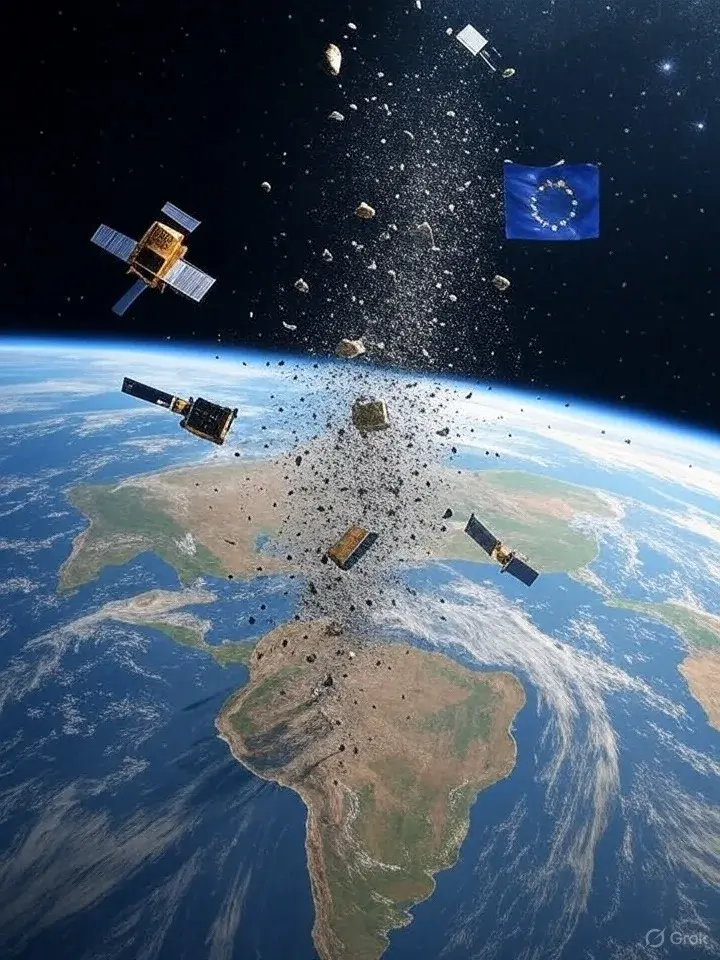EC Staff Say Stakeholders Want Option 2+ with a Binding Framework Based on Survey Responses
The EU Space Act’s preferred “Option 2+” — a mandatory framework aiming to cut orbital debris 50% by 2034 — leans too heavily on stakeholder surveys and a worst-case reading of the Kessler Effect. Evidence on when and where Kessler cascades might occur is uncertain (especially across different altitude bands), and EU consultation survey methods are not suited to justify sweeping mandates. The EU Space Act fails to consider the emergence of dynamic, market-driven waste mitigation given growing incentives for debris-removal services. Innovation and investment by US firms in space launch and satellite development will likely be chilled by an overly conservative binding framework if the EU Space Act is passed.
The EU Space Act[2] will implement a mandatory binding framework in orbital debris regulation with the goal to lower total space debris by 50% by 2034.[3] This approach takes a catastrophic view of the Kessler Effect without taking into account industry trends. As space activity increases, so too do market incentives for space debris removal services as global space revenues grow.
The Kessler Syndrome[4] or Kessler effect can lead to unusable space due to the cascading effects of space debris collisions. Yet a consensus view does not exist on when and how the Kessler effect will play out. Low earth orbit debris below 500-km is less susceptible to the Kessler effect where atmospheric drag and natural burn lead to cleansing of the space, while debris above 600-km to the 800 to 1000-km range where fewer GEO satellites and spacecraft operate take centuries to naturally drag down.[5]
The June 25, 2025 impact analysis[6] prepared by European Commission staff is cited as “broad support in the industry” for the EU Space Law with comparison of 4 policy options (option 1, 2, 2+, 2++) ranging from voluntary to mandatory space debris regulations. The staff recommendation of Option 2+ with a binding framework is based on survey responses: “The preferred option is broadly supported by the stakeholders consulted. Overall, 46% of the respondents to the targeted consultation ranked policy option 2+ as the option most likely to achieve the objective.”[7]
While it seems rigorous to collect 333 comments, 44 replies, 65 documents from 170 organizations and 153 citizens, half were from industry and research stakeholders, while the remainder were from unspecified entities.[8] This is problematic because the report takes as evidence these general survey responses, with agree or disagree votes that do not appear to be weighted, cited, or qualified by randomization or discrete choice methods. (“An overwhelming majority of respondents agree (19.3%) or strongly agree (72.7%) that a growing risk of collision stemming from an intensification of space activities.”[9]). A single response of an environmental organization appears to be treated the same as a single response of a space company in this survey format.
The report uses these stakeholder consultation findings with a static view of the space industry to make a stark conclusion that a binding framework is needed to reduce space debris by 50% by 2034.[10] At this level, perhaps the EU Space Act might as well put a moratorium on space launches, after all, the European Space Agency (ESA) has calculated that space debris will continue to grow over the next 200 years even with no additional space launches.[11]
Furthermore, survey questions do not reveal useful probabilities or timeline for the Kessler effect. The Kessler effect is impending but definitive timelines do not exist because it depends on the rate and nature of space activity at low, mid, and high altitudes.
The impact analysis fails to incorporate any dynamic analysis that could introduce waste management investments as space launch activity grows. As the global space industry grows, there become greater incentives for profit-making enterprises to serve the space sector.
Clean-up services are complementary and defensive for business models that need to manage risk of collision. One example is an effort like ESA CleanSpace-1, a mission of the European Space Agency subcontracted to Swiss start up ClearSpace SA to remove the PROBA-1 satellite from orbit.[12] Another is Astroscale U.S. which is a global company that offers on-orbit-debris-removal services in LEO.[13]
Lastly, the impact analysis upon which the EU Space Act relies upon heavily does little to analyze the Kessler effect itself, instead relying on survey responses and respondent sentiment. The EU Space Act proposal claims benefits of mandatory debris regulation of 677.5 million euros,[14] which does not take into account the opportunity costs of a chill on space activity that could far exceed that level of monetary benefit.
The global space industry is expected to grow at 9% annually from $630 billion to $1.8 trillion in 2035 according to the World Economic Forum.[15] As the Kessler effect becomes more likely with more debris at low, but more importantly, middle and high altitudes, there will be industry efforts in the marketplace to protect investments through waste management and cleanup technologies.
The EU Space Act fails to incorporate projections of dynamic responses in a marketplace that can create technologies to mitigate debris without chilling investment, launch activity, and opportunity costs of diminished space development. Innovation and investment by U.S. firms in space launch and satellite development will likely be chilled by an overly conservative binding framework if the EU Space Act is passed.

[1] Senior Fellow, Technology Policy Institute, 2001 L Street NW, Suite 500, Washington, D.C. 20036, [email protected]. The views expressed here are those of the author and do not necessarily reflect those of TPI’s staff, board of directors, or board of academic advisors. This essay has been published online at https://sarahlam.substack.com/p/is-the-kessler-effect-overplayed.
[2] EU Space Act, Proposal for a Regulation, June 25, 2025, https://defence-industry-space.ec.europa.eu/eu-space-act_en, https://defence-industry-space.ec.europa.eu/document/download/0adeee10-af7a-4ac1-aa47-6a5e90cbe288_en?filename=Proposal-for-a-Regulation.pdf.
[3] SWD – Impact Assessment Report Part 1 at p. 49, June 25, 2025, https://defence-industry-space.ec.europa.eu/document/download/18cb5e4d-c060-4ca8-b15c-00a45cd5f61a_en?filename=SWD-Impact-assessment-report-part1.pdf.
[4] Donald J. Kessler and Burton G. Cour-Palais, “Collision Frequency of Artificial Satellites: The Creation of a Debris Belt,” June 1, 1978, Journal of Geophysical Research Space Physics, Vol. 83, Issue A6, pp. 2637-2646, https://agupubs.onlinelibrary.wiley.com/doi/abs/10.1029/JA083iA06p02637.
[5] Jon Kelvey, Understanding the Misunderstood Kessler Syndrome, Mar. 1, 2024, Aerospace America, https://aerospaceamerica.aiaa.org/features/understanding-the-misunderstood-kessler-syndrome.
[6] SWD – Impact Assessment Report Part 1, June 25, 2025, https://defence-industry-space.ec.europa.eu/document/download/18cb5e4d-c060-4ca8-b15c-00a45cd5f61a_en?filename=SWD-Impact-assessment-report-part1.pdf, SWD – Impact Assessment Report Part 2, June 25, 2025, https://defence-industry-space.ec.europa.eu/document/download/b093b1ce-91ca-41af-bd8e-817026c2c1c3_en?filename=SWD-Impact-assessment-report-part2.pdf.
[7] Executive Summary of the EU Space Act, at p. 2, https://defence-industry-space.ec.europa.eu/document/download/84813bcb-51e3-4b49-bc8b-0ad53b8677c0_en?filename=SWD-Executive-summary-of-the-impact-assessment.pdf.
[8] Impact Assessment Report Part 1, p. 49.
[9] Impact Assessment Report Part 2, p. 16.
[10] Impact Assessment Report Part 1, at 49, Impact Assessment Report Part 2, p. 42.
[11] Kelvey, id.
[12] European Space Agency, ClearSpace-1, https://www.esa.int/Space_Safety/ClearSpace-1
[13] Astroscale U.S., https://astroscale-us.com/.
[14] Impact Assessment Report Part 2, p. 42; EU Space Act, p. 118.
[15] World Economic Forum, “Space is booming. Here’s how to embrace the $1.8 trillion opportunity”, Apr. 8, 2024, https://www.weforum.org/stories/2024/04/space-economy-technology-invest-rocket-opportunity.
Sarah Oh Lam is a Senior Fellow at the Technology Policy Institute. Oh completed her PhD in Economics from George Mason University, and holds a JD from GMU and a BS in Management Science and Engineering from Stanford University. She was previously the Operations and Research Director for the Information Economy Project at George Mason School of Law. She has also presented research at the 39th Telecommunications Policy Research Conference and has co-authored work published in the Northwestern Journal of Technology & Intellectual Property among other research projects. Her research interests include law and economics, regulatory analysis, and technology policy.


